Removable Wallpaper for Apartments A Renter's Guide
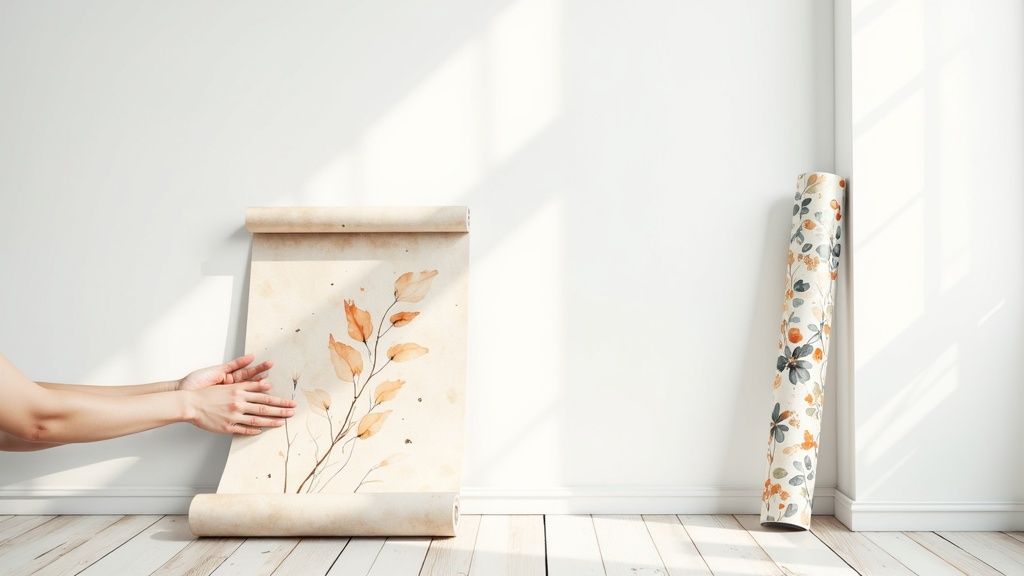
Tired of staring at the same old boring, beige walls in your apartment? You’re not alone. For renters, adding a personal touch can feel impossible, but removable wallpaper is a total game-changer. It’s the perfect way to inject some serious style and personality into your space—completely damage-free and without saying goodbye to your security deposit.
Think of it as a commitment-free design solution that can transform a room in just a few hours.
Why Removable Wallpaper Is a Renter’s Best Friend
Let’s face it, most rental agreements have a strict no-paint policy, and traditional wallpaper? That’s definitely out of the question. This is exactly where peel-and-stick wallpaper shines, closing the gap between a temporary space and a place that actually feels like home.
Unlike its messy, glue-based ancestor, this modern decor hack is designed for a super simple application process and, crucially, a clean getaway when it’s time to move out.
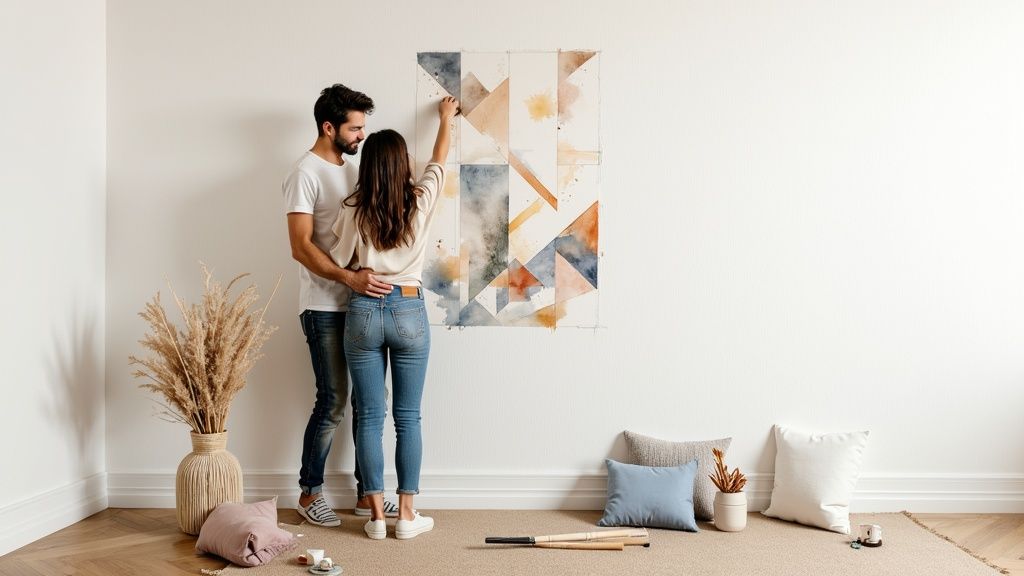
The real magic is its power to completely shift the vibe of a room without making a single permanent change. You could create a stunning accent wall behind your bed, bring a splash of color to a bland entryway, or even line the back of a bookshelf for a surprisingly custom look.
A Growing Trend for Modern Renters
This isn’t just some niche product anymore; it’s a booming market designed specifically for people like us. The removable wallpaper market is expected to jump from USD 2.0 billion in 2025 to USD 2.8 billion by 2035. This incredible growth is all thanks to a wave of renters who want beautiful, personalized homes without the long-term ties.
What does that mean for you? More options than ever. We’re talking everything from subtle, elegant textures to bold, artistic murals that look like a professional painted them. It gives you the power to take charge of your decor, making it a star player in tons of creative DIY room makeover ideas.
The best part? When your lease is up or you’re just ready for a change, you literally just peel it off. The wallpaper comes down cleanly, leaving the wall in perfect condition. It’s the ultimate blend of high-impact style and low-stakes commitment.
Removable vs. Traditional Wallpaper: A Renter’s Comparison
Here’s a quick breakdown of why removable wallpaper is the clear winner for apartment living.
| Feature | Removable Wallpaper | Traditional Wallpaper |
|---|---|---|
| Application | Peel-and-stick; DIY-friendly | Requires paste, water, and tools; messy |
| Removal | Peels off cleanly in minutes | Difficult, often requires steaming and scraping |
| Damage Risk | Very low; leaves no residue | High; can damage drywall and paint |
| Cost | More affordable upfront | Higher cost for materials and professional labor |
| Best For | Renters, dorm rooms, temporary projects | Homeowners, long-term installations |
As you can see, for anyone living in a rental, the choice is pretty clear. Removable wallpaper gives you all the style without any of the stress.
How to Choose the Right Wallpaper for Your Apartment
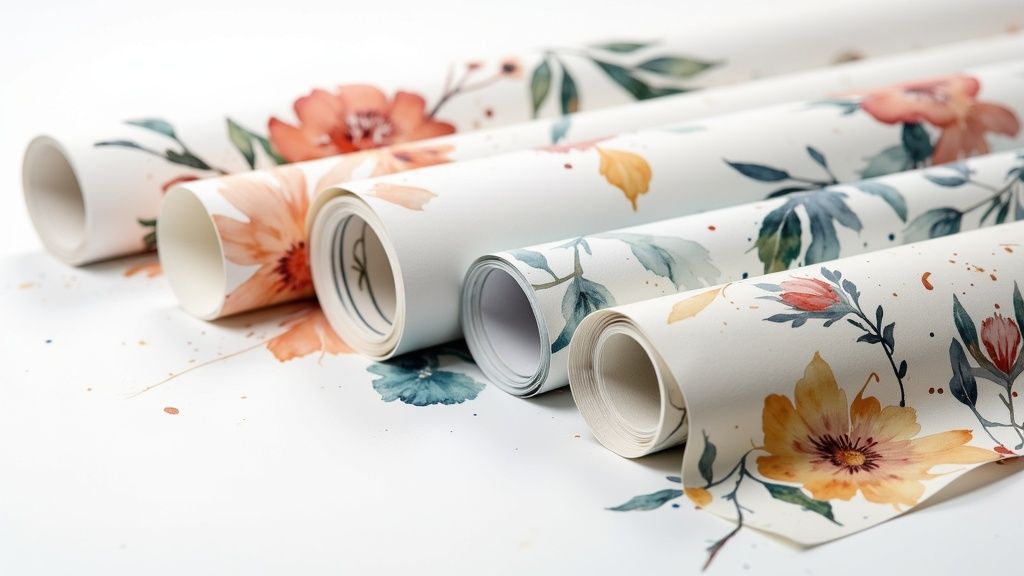
It’s easy to get swept up in the excitement of a gorgeous pattern you see online, but picking the right removable wallpaper is about more than just a pretty design. For a project to go smoothly—and to make sure you get that security deposit back—you need a smart game plan.
Your first move, before you even think about adding rolls to your cart, is to order samples. Seriously, don’t skip this. Colors look completely different on a backlit screen than they do in real life. That perfect muted sage green you fell for online could easily turn into a glaring lime green under your living room lamps.
Samples let you see how the colors and textures truly look in your home’s unique light throughout the day. Even more critically, they let you test the adhesive. Find a hidden spot, maybe behind the couch or a door, stick up a sample, and leave it for a couple of days. Is it staying put? Does it peel off cleanly without taking any paint with it? Answering these questions now will save you a world of hurt later.
Harmonize with Your Existing Decor
Once you know a brand plays nice with your walls, it’s time to think about the bigger picture. You want a wallpaper that feels like a natural part of your space, not something that’s fighting with your furniture and rugs for attention.
- Got a small or dark room? Look for patterns with light backgrounds—think cream, white, or soft pastels. These shades are great for bouncing light around, which can make a tight space feel way bigger and brighter.
- Working with a large, sunny space? Go for it! This is your chance to play with bold, large-scale graphics or even a dramatic, dark color to create an incredible focal point.
- Check your furniture. If you have a solid-colored sofa and chairs, a wallpaper with an intricate pattern can add a much-needed layer of personality. But if your rug and pillows are already busy, a simpler, more textured design will keep the room from feeling chaotic. For a deeper dive, our guide on how to choose color schemes has some great pointers.
Calculate and Purchase the Right Amount
There is nothing worse than getting halfway through a project only to realize you’re one roll short. To avoid that momentum-killer, you’ll need to do a little bit of math. Grab a tape measure and find the height and width of each wall you’re covering. Multiply those numbers together to get your total square footage.
Here’s the key: always buy 10-15% more wallpaper than you think you need. This isn’t about being wasteful; it’s about being prepared. That extra bit covers you for any mis-cuts, allows you to work around tricky spots like outlets and windows, and most importantly, accounts for matching the pattern.
Pro Tip: To get a seamless, professional look, you have to line up the pattern from one panel to the next. This almost always means trimming some excess material off the top or bottom of a new roll. That “waste” is what the extra 10-15% is for, ensuring you don’t run out before the job is done.
The market for peel-and-stick wallpaper is booming—it’s expected to grow from an estimated USD 3.5 billion in 2024 to around USD 5.7 billion by 2033. That’s great news for renters because it means more options than ever, with prices for a single roll typically falling between $20 and $100. Investing in a quality product and buying the right amount from the get-go is the secret to a stress-free transformation.
A Realistic Guide to Flawless Installation
Alright, are you ready to actually get that wallpaper on your wall? Let’s be real—putting up peel-and-stick wallpaper isn’t rocket science, but taking your time and doing a bit of prep work is the difference between a pro-level finish and a bubbly, crooked mess.
Forget those mesmerizing, sped-up TikTok videos. The most crucial part of a great installation happens before you even think about peeling off the backing. Your walls absolutely must be clean and smooth.
Give the entire surface a good wipe-down with a damp cloth to get rid of any dust or grime. Let it dry completely. For an even deeper clean, a 50/50 mix of rubbing alcohol and water will cut through any grease you can’t see. Then, run your hand over the wall. Seriously. Any little bumps, old paint drips, or nagging imperfections will absolutely show through the wallpaper. A quick, light sanding will solve that.
Your Essential Toolkit
You don’t need to buy out the hardware store, but a few key items will save you a world of frustration. Get these ready before you start.
- A Sharp Craft Knife: Do not try this with scissors. A fresh blade on a craft knife (like an X-Acto) is the only way to get those satisfyingly clean cuts around outlets and trim.
- A Smoothing Tool: A simple plastic wallpaper smoother is best, but in a pinch, a credit card or even a flexible silicone spatula from the kitchen will work. You need this to push out air bubbles.
- A Step Ladder: Unless you’re tackling a wall that’s three feet tall, you’ll need a sturdy ladder to safely reach the top.
- A Level and Pencil: I can almost guarantee your apartment’s ceilings and corners aren’t perfectly straight. Use a level to draw a very faint vertical guideline for your first piece. This is your anchor for a straight application.
Applying Your First Panel
This first piece sets the stage for the entire wall, so take a deep breath and don’t rush it. Whatever you do, resist the temptation to peel the entire backing off at once. That’s how you end up with a giant, sticky mess that’s folded in on itself, potentially ruining the panel.
Instead, just peel back the top six inches or so. Line up the top edge of the wallpaper with the ceiling, leaving an extra inch to trim off later for a clean line. Now, align the side of the panel with that pencil line you drew. Once you’re happy with the placement, press that top section firmly against the wall.
The real trick is to work from the top down. Slowly pull the backing away with one hand while you use your other hand to smooth the wallpaper onto the wall. This method gives you total control and is the best way to prevent bubbles and creases.
Now you can get into a rhythm. Work from the center of the panel outward, pushing any air bubbles toward the edges with your smoothing tool. Don’t panic if a big one appears! Most quality wallpapers are forgiving; you can gently lift a section and re-apply it without losing stickiness.
This simple infographic gives you a great visual of the core steps.
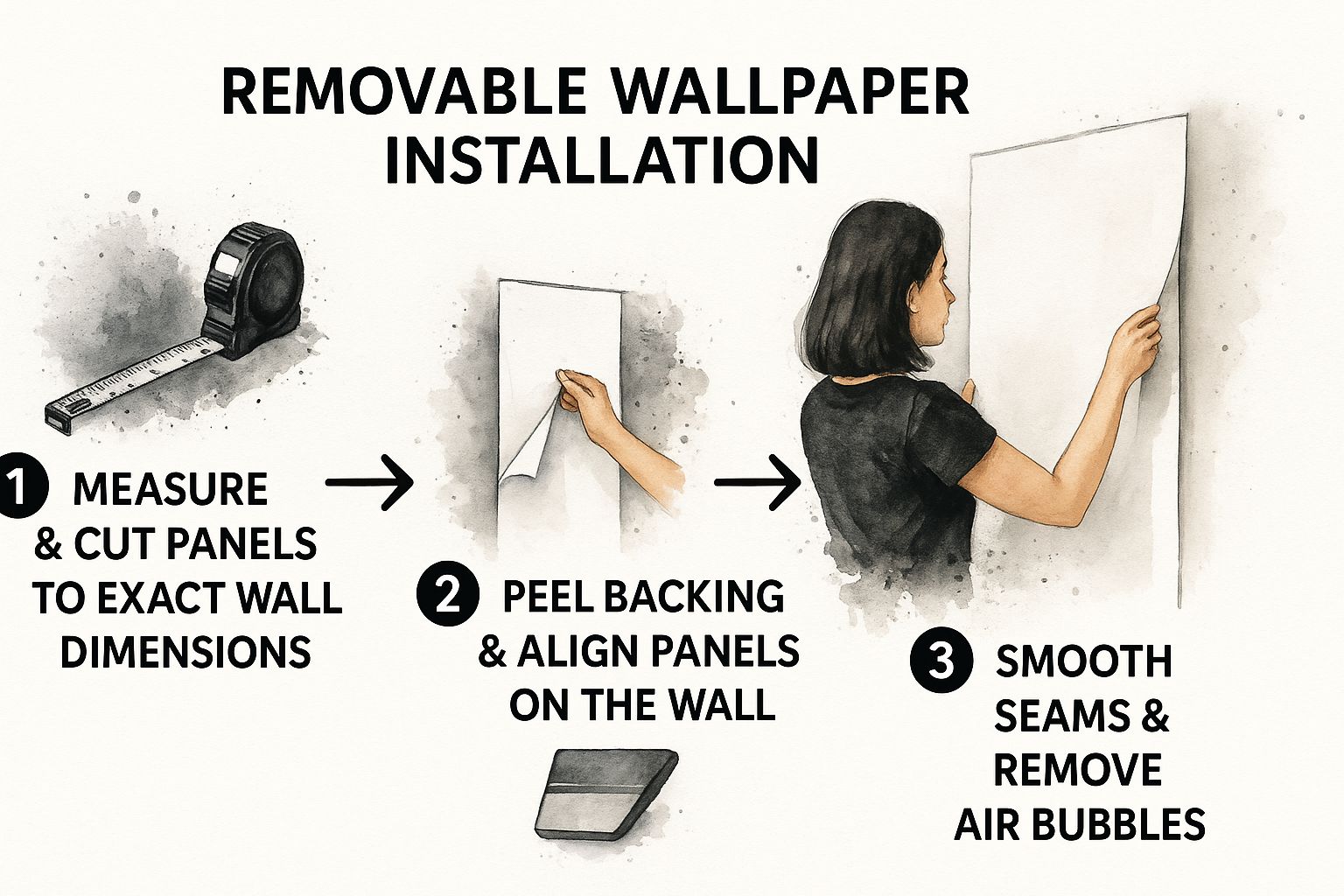
As you can see, it’s all about a methodical approach. Measure carefully, align with patience, and smooth everything out as you go.
Overlapping and Pattern Matching
When you’re ready for the second panel, the process is the same, but now you’ve got a new challenge: lining up the pattern. Most removable wallpaper is designed to be overlapped by about a half-inch. This tiny overlap is a lifesaver, as it prevents gaps from appearing if your walls shift with temperature changes.
Slowly apply the next panel right beside the first, focusing all your attention on matching the pattern at the seam. This is where you’ll thank yourself for buying 10-15% extra wallpaper. You’ll often have to trim a bit from the top of a new roll to get the pattern to repeat perfectly. Once it’s aligned, smooth it down, giving that seam extra pressure.
For tricky spots like outlets, turn off the power at the breaker first. Then, remove the faceplate, apply the wallpaper right over the opening, and use your craft knife to carefully cut out the hole. Pop the cover back on, and you’re done.
Creative Ways to Use Wallpaper in a Rental
Sure, an accent wall is a great start, but don’t box yourself in. Think of removable wallpaper as your secret weapon for transforming a rental, especially when you’re dealing with awkward layouts or those bland, builder-grade finishes. It’s more than just a wall covering; it’s a way to add personality and solve design problems.
For instance, in an open-concept studio, wallpaper is brilliant for creating distinct zones. I’ve seen clients use a bold, graphic pattern behind a desk to carve out a dedicated “office” space, making it feel separate from the living area. You can do the same thing behind a sofa to anchor your seating arrangement, giving it a cozier, more intentional vibe. It’s an easy way to add architectural interest that most rentals lack. If you want to dive deeper into this, you should check out our guide on making the most of a compact apartment.
Style Small But Mighty Spaces
Look past the big walls and start noticing the little nooks and crannies begging for some attention. These small-scale projects are perfect for a weekend afternoon, don’t cost much, and deliver a huge design payoff.
- Bookshelf Backing: This is one of my favorite tricks. Applying a fun pattern to the back of a plain bookshelf instantly makes it look like a high-end, custom piece.
- Door Details: That boring, flat closet door? It’s a blank canvas. A striking geometric or floral pattern can turn it from a functional necessity into a work of art.
- Entryway Definition: Even the smallest entryway deserves to make a good first impression. Wallpapering that little slice of wall by your front door creates a welcoming, defined spot to greet guests.
Using removable wallpaper in these unexpected places is about more than just adding color—it’s about creating layers and depth. It tricks the eye into seeing a more thoughtfully designed, high-end space, even on a renter’s budget.
Upgrade Your Apartment’s Fixed Features
Let’s be honest, many rentals come with features that are functional but far from stylish. Removable wallpaper gives you a damage-free way to upgrade these elements without getting on your landlord’s bad side.
A great example is creating a faux headboard. Just apply a rectangular panel of wallpaper on the wall behind your bed. It adds a beautiful focal point to the room without the cost or bulk of a real headboard.
The kitchen backsplash is another fantastic spot. Many brands now offer vinyl or water-resistant options that are perfect for this. It’s an incredibly fast way to hide dated tile and give your kitchen a modern facelift. This trend has exploded in popularity—the global removable wallpaper market was valued at approximately USD 1.99 billion in 2024, and it’s not just for homes anymore. You can see more on this growing market over at MarketResearchFuture.com.
Fixing Common Wallpaper Mishaps
Even the most seasoned DIYer hits a snag now and then. Don’t panic—most wallpaper issues are surprisingly easy to fix. Knowing a few tricks of the trade can turn a moment of “oh no” into a minor, fixable blip.
The most common headache? That stubborn air bubble that refuses to be smoothed out. While tiny ones often disappear on their own as the wallpaper cures, larger bubbles need a more direct approach. Whatever you do, don’t try to force them out with a smoother; you’ll just end up stretching or creasing the panel, which is a much bigger problem.
For those persistent air bubbles, a specialized wallpaper bubble-out syringe is your best friend. This little tool lets you inject a tiny bit of adhesive right into the bubble, allowing you to flatten it perfectly without peeling back the whole sheet. It’s a clean, simple fix that works like a charm.
Lifting and Repositioning a Panel
You’ve smoothed down a whole panel, stepped back to admire your work, and… the pattern is just a little bit off. Your heart sinks. But take a deep breath, because quality removable wallpaper for apartments is designed for this very moment. The key is to work slowly and gently.
Start at a top corner and begin peeling the panel away from the wall at a 45-degree angle. Avoid pulling straight down, as this can easily stretch the material and make it impossible to line up correctly again. Once you’ve lifted it far enough, just reapply it slowly from the top down, smoothing as you go.
Don’t be afraid to lift and try again. Most high-quality peel-and-stick wallpapers are designed to be repositioned multiple times during installation without losing their tackiness, as long as the wall was properly cleaned beforehand.
Dealing with Challenging Surfaces
Let’s be real: most apartment walls aren’t perfectly smooth. That common “orange peel” texture can feel like a dealbreaker, but it doesn’t have to be. With the right approach, you can still get a fantastic result.
- Choose Thicker Wallpaper: A more substantial, high-quality paper is far more forgiving and less likely to telegraph the texture underneath.
- Test a Large Sample: Before you commit, stick a large sample in a less-visible spot. Leave it up for a few days to see how well it adheres and if the texture shows through.
- Clean Thoroughly: For textured walls, this step is non-negotiable. A wipe-down with a 50/50 mix of rubbing alcohol and water will remove any residue and give the adhesive the best possible grip.
Thinking through these potential hiccups ahead of time means you’ll be ready for anything, ensuring your new wallpaper looks like it was done by a pro.
Taking It Down Without the Headache
So, your lease is ending, or maybe you’re just itching for a change. This is where you’ll really appreciate choosing peel-and-stick wallpaper. Unlike its traditional counterpart that often means a nightmare of steamers and scrapers, this stuff is made to come off cleanly.
The Art of the Peel
The best way to start is by picking at a top corner of one of the panels. Once you’ve got a good grip, begin pulling it away from the wall.
Here’s the trick I’ve learned from experience: pull down slowly and at about a 45-degree angle. Don’t just yank it straight down! That’s how you end up with stretched-out wallpaper or, worse, peeling paint.
If you hit a stubborn spot and feel some resistance, don’t force it. Just grab a hairdryer, put it on a low heat setting, and gently warm up that section. This usually softens the adhesive just enough to let it release without a fight.
The Final Clean-Up
In most cases, the wallpaper will come off without leaving a trace. But every now and then, you might find a few sticky spots left behind. No big deal.
You can easily tackle this with a soft cloth and some warm, soapy water. If that doesn’t cut it, a 50/50 solution of rubbing alcohol and water almost always does the job.
For anyone renting, getting that security deposit back is the ultimate goal. A clean removal is a huge part of that, but don’t forget the rest of the apartment. Following an ultimate end of tenancy cleaning checklist can make the whole move-out process a lot less stressful.
Answering Your Top Removable Wallpaper Questions
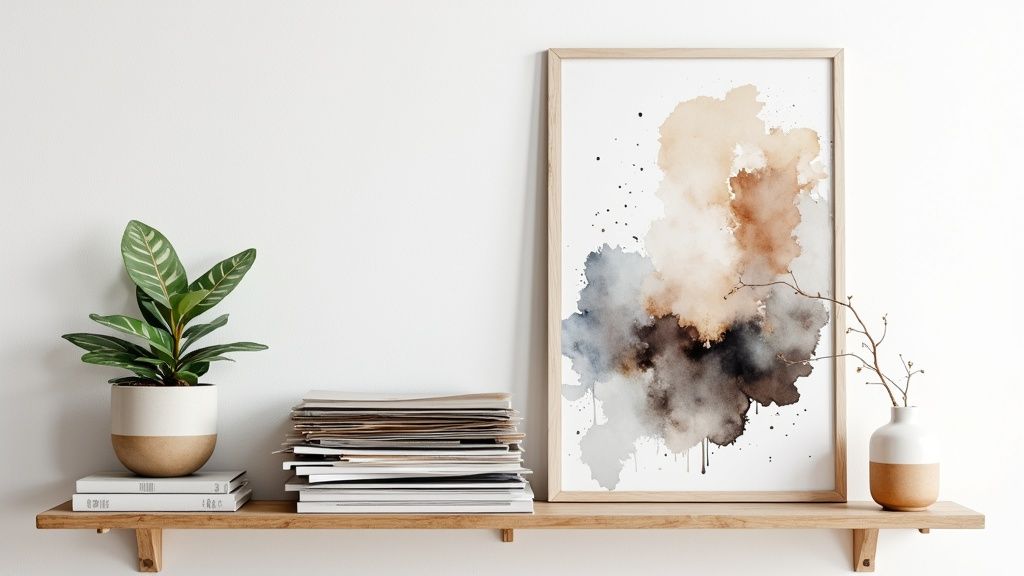
Even after walking through the process, it’s completely normal to have a few more questions pop up. Let’s tackle some of the most common things renters wonder about before jumping into a peel-and-stick project.
Can You Really Put Removable Wallpaper on Textured Walls?
This is probably the number one question I get, and the honest answer is: it depends. Most brands of removable wallpaper for apartments are really made for smooth, flat walls. That’s where you’ll get that perfect, seamless look.
If your walls have a very light texture, like a subtle “orange peel,” you might have some luck with a thicker, high-quality wallpaper. But for anything heavier—think popcorn ceilings or knockdown texture—the adhesive just can’t get a solid grip, and you’ll almost certainly face peeling corners down the road.
The only way to know for sure is to test it out. Order a sample and stick it in an out-of-the-way spot for a few days. It’s a small step that can save you a huge headache and a lot of money.
How Long Does Removable Wallpaper Actually Last?
When you’ve prepped your wall correctly and taken your time with the application, a good quality removable wallpaper can last for years—often well beyond the length of a standard lease.
A few things can affect its lifespan, though.
- Humidity: I’d be cautious about using it in a bathroom with poor ventilation, as constant steam can weaken the adhesive over time.
- Wall Condition: Starting with a clean, smooth, properly cured wall is crucial for longevity.
- Product Quality: Reputable brands design their products for the long haul, so they’ll stay put until you’re ready to move out.
Will It Actually Come Off Without Damaging the Paint?
Yes, it really should! Damage-free removal is the whole point. But there are two non-negotiables for making sure that happens: solid prep work before you start and a little patience when you take it down.
First, your paint needs to be fully cured. If your landlord just painted, you absolutely must wait at least 30 days before applying anything to the walls. When it’s time to move out, peel it back slowly and at a 45-degree angle.
If the paint was already chipping or was poorly applied in the first place, you might see some flecks come off. But in that case, the issue is with the paint job itself, not the wallpaper.
Ready to stop dreaming about your perfect space and start creating it? With RoomGenius, you can upload a photo of any room and see stunning redesigns in seconds. Find your style and get inspired today! https://www.room-genius.com